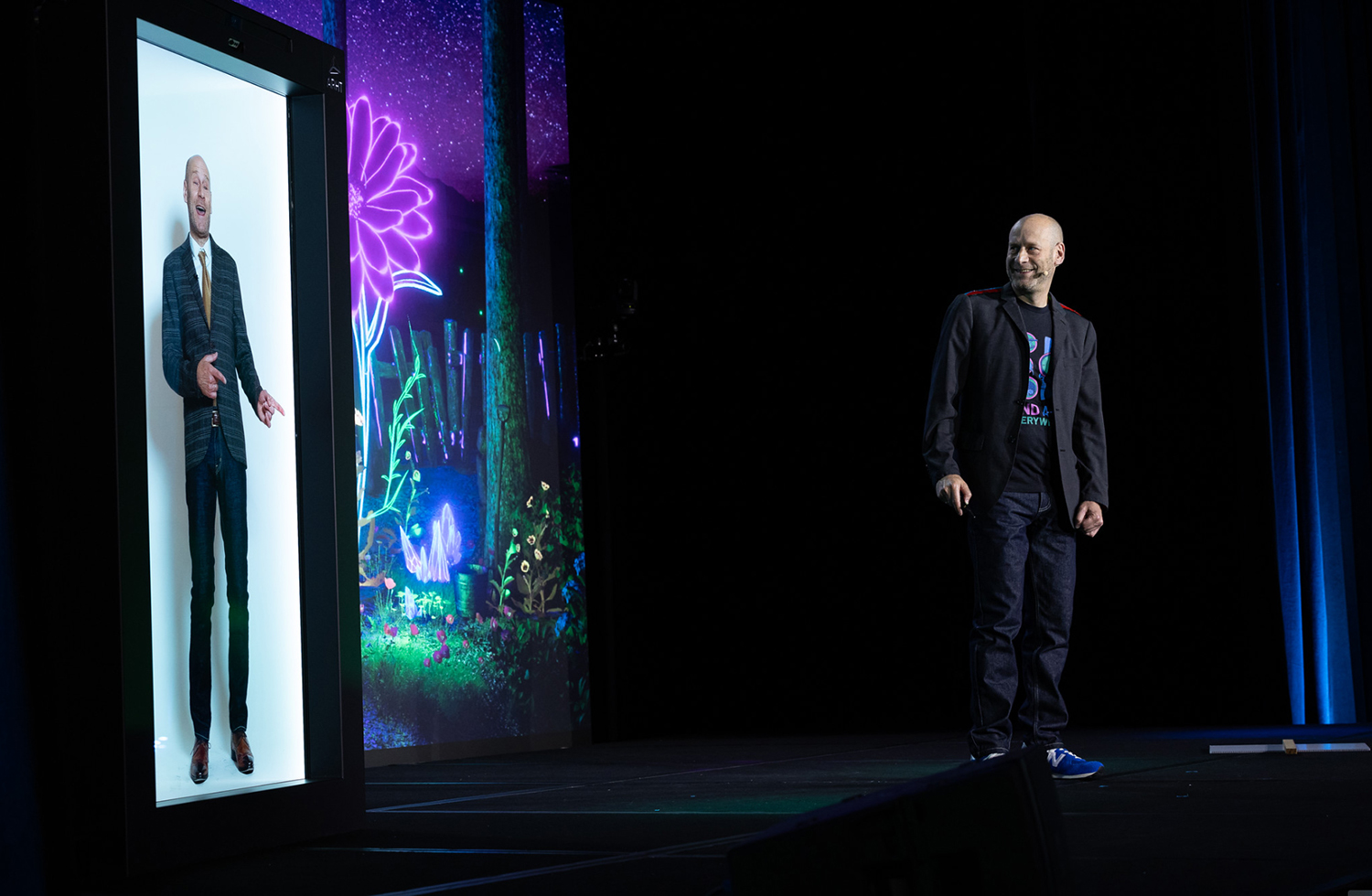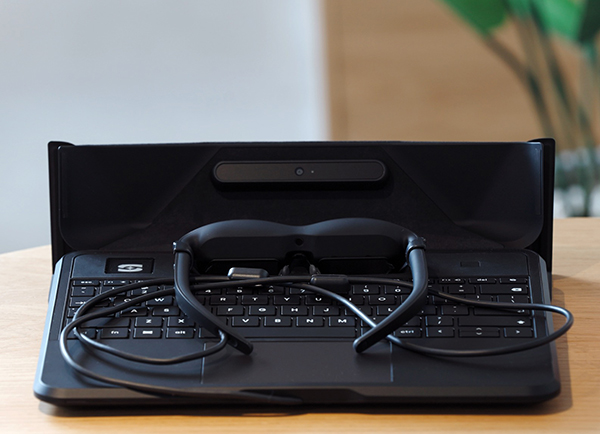
Ori Inbar, AWE’s founder, appears alongside a holographic version of himself to open the keynote. Image courtesy of AWE.
Latest News
June 9, 2023
At AWE 2023 (May 31-June 1, Santa Clara, California), attendees awaited the conference's founder Ori Inbar to open the keynote. He eventually did, but it's more accurate to say, a lifesize hologram of Inbar opened the conference, delivering an AI-written script. “This year's event, promises to be the biggest and the most exciting yet,” said the Hologram Inbar.
The real Inbar appeared later, standing next to his holographic twin. “What do you think? Did he do a good job?” asked the real Inbar with a cheeky smile. “It was pretty good, but I also think it's a big pile of cliche, nothing authentic. Just statistical regurgitation of things said by other humans. But here is the good news. This makes original voices even more valuable,” he added.
It's a sign of the times—the paradoxical times that put humans in a quandary. Humans feel threatened by AI's ability to mimic them; but paradoxically, AI entities, like Inbar's holographic double, also need voice and video footage of the real Inbar for machine learning. Whether this paradigm is one of competition, coopetition, or collaboration is still unclear.
Invisible Laptop
If Sightful's AR laptop becomes commonplace, portable laptop cases may become a thing of the past. Spacetop, on display at AWE 2023, consists of a keyboard and a pair of AR glasses. There's no display panel because the screen unfolds before you inside the AR glasses when you launch it. The company describes it as the first AR laptop: “A personal computer that reimagines the traditional laptop, offering a portable 100-inch augmented reality workstation display, lightweight design, private browsing, and equipped with 5G connectivity.”
But before you pull out your credit and attempt to order it, you should know the unit is still in Early Access program, not available to the general public. You need to fill out a form and see if you qualify for purchase. If you do, be prepared to part with about $2,000.
 .
.
Training and Remote Expert
For AR hardware and application developers looking to sell into enterprises, training and remote assistance are the two key areas with growth potentials. Elizabeth Hyman, CEO of XR Association, said, “Because you can go into an immersive experience, and you can do something over and over and over again in a way that is safe, you're building up that muscle memory to do something.”
EPSON was one of the exhibitors demonstrating their AR gear at the conference. EPSON offers MOVERIO AR products for remote assistance. Its binocular glasses are powered by Si-OLED micro projection technology with 360- degree field of view. “In remote assistance, the field technician is wearing the headset and connect to a remote expert. Through the headset camera, [the expert] can see what the field technician is seeing and provide him guidance in a couple of different ways. It could be verbal, could be annotation over the camera feed, could be document sharing or video sharing, so they collaborate together to get a problem resolved.”
For effective training using AR, aside from the visuals, haptic feedback also plays an important role. Muscle memory is a critical skill to acquire in manufacturing jobs. This is a specialty of HaptX, which offers gloves with force feedback. At AWE, the company showcased its kitchen design application, developed in collaboration with Lowe's Innovation Lab, a division of the home improvement merchant Lowe's.
Chasing the Metaverse
For many, enterprise training and applications will likely take place inside an immersive environment, like NVIDIA Omniverse. Vishal Shah, GM of XR & Metaverse at Lenovo, said, “The metaverse, at a very high level, is the internet moving from 2D to a spatial 3D environment. And we strongly believe that ARVR devices are going to be a key gateway into that spatial experience.”
Lenovo offers ThinkReality VRX, a series of ARVR devices powered by the Qualcomm Snapdragon XR chipsets. “If you look at the major skill gaps in manufacturing, for example right now, the big goal is, 'How can I train my workers rapidly? How can I bring the training time down from six weeks to two days?' And we've learned over and over again, through real use cases, that through learning on AR VR devices, you can actually have 60-70% reduction in the training time and a significantly higher retention of what they are learning.”
In AR, in addition to convincing visuals, the app also needs to solve another problem: to synchronize the projected digital object to the real world in the right orientation, with the correct aspect radio. Rishi Ranjan, CEO & Founder of the cloud-hosted XR platform GridRaster, said, “We are making alignment really scalable so that customers can do millions of object alignment in no time.” Ranjan is also betting on smaller, lighter devices becoming the norn, allowing users to wear AR devices much longer than the usual 45-60 mins limit. “We have seen that ARVR devices will evolve to become something you can wear eight hours a day, and that these devices starting to replace our smartphones.”
If his prediction is correct, processing power would have to come from the cloud, not embedded in the hardware itself. If so, for content delivery, the cloud would be the preferred method.
For extended interviews with the companies mentioned here, watch the video report above.
More Lenovo Coverage

Subscribe to our FREE magazine, FREE email newsletters or both!
Latest News
About the Author
Kenneth Wong is Digital Engineering’s resident blogger and senior editor. Email him at [email protected] or share your thoughts on this article at digitaleng.news/facebook.
Follow DE






